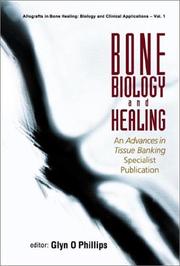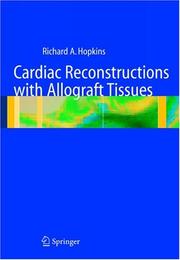| Listing 1 - 3 of 3 |
Sort by
|

ISBN: 128193383X 9786611933838 9812791299 9789812791290 9812382801 9789812382801 Year: 2003 Publisher: River Edge, NJ : World Scientific,
Abstract | Keywords | Export | Availability | Bookmark
 Loading...
Loading...Choose an application
- Reference Manager
- EndNote
- RefWorks (Direct export to RefWorks)
This book describes succinctly the factors which affect the incorporation of massive and morsellised allografts after transplantation. Unless special precautions are taken, massive allografts when implanted can undergo stress fatigue, due to the limited incorporation at the graft-host interface. Immunological and cell signalling growth factors can be shown to greatly influence the behaviour of the graft. The bone-biological processes are illustrated in terms of demineralised bone, which can initiate bone induction due to the protection and availability of the original bone-morphogenic protein.
Bone-grafting. --- Homografts. --- Allogeneic homografts --- Allografts --- Homologous transplants --- Transplantation of organs, tissues, etc. --- Bones --- Grafting of bone --- Osteoplasty --- Homografts --- Surgery --- Surgery, Experimental --- Surgery, Plastic --- Transplantation

ISBN: 1280263563 9786610263561 0387265155 0387949623 1441928596 Year: 2005 Publisher: New York, NY : Springer,
Abstract | Keywords | Export | Availability | Bookmark
 Loading...
Loading...Choose an application
- Reference Manager
- EndNote
- RefWorks (Direct export to RefWorks)
Cryopreserved allograft tissues are now standard materials for the reconstructive cardiac surgeon. Since publication of the first edition ("Cardiac Reconstructions with Allograft Valves") in 1989, the field has progressed dramatically with increased clinical use of cardiovascular allograft tissues, with the development of new surgical techniques, and with advances in the understanding of the fundamentals of valve transplantation biology and cryopreservation. As a result, over two-thirds of the present volume represents new material. Fifty-six authors bring their expertise to thirteen comprehensive, lavishly illustrated sections which discuss the principles of the use of homograft valves, major clinical series of homograft valves for both left and right ventricular outflow tracts, cryopreserved allograft tissue for cardiac reconstruction, cell biology of heart valve leaflets, cryobiology of heart valve preservation, morphological, biochemical, and explant pathology studies of allograft heart valves, allograft valve banking, as well as detailed explanation of surgical techniques for valve and root methods for left and right ventricular outflow tract reconstructions, the Ross operation and variants, and complex reconstructions. A final section presents potential future directions for the field. Over 400 illustrations, created expressly for this book, depict the surgical techniques from the perspective of the surgeon standing at the operating table. All surgeons performing pediatric and/or adult valve replacements and reconstructive cardiac surgeries will benefit from the described methods. Cardiothoracic residents and cardiologists will also find the text useful. It will provide the surgeon with an enhanced understanding of the biological and material properties of allografts and increased familiarity with the range of surgical techniques applicable for the use of these valves, particularly in the successful management of challenging cardiac reconstructions.>.
Heart valves --- Homografts. --- Surgery. --- Allogeneic homografts --- Allografts --- Homologous transplants --- Transplantation of organs, tissues, etc. --- Heart --- Cardiology. --- Cardiac Surgery. --- Internal medicine --- Cardiac surgery --- Open-heart surgery --- Diseases --- Surgery --- Cardiac surgery.
Book
Year: 2021 Publisher: Basel, Switzerland MDPI - Multidisciplinary Digital Publishing Institute
Abstract | Keywords | Export | Availability | Bookmark
 Loading...
Loading...Choose an application
- Reference Manager
- EndNote
- RefWorks (Direct export to RefWorks)
Materials science and engineering are strongly developing tools with increasing impact in the biotechnological and biomedical areas. Interestingly, research in molecular and cellular biology is often at the core of the design and development of materials-based approaches, providing biological rationale. Focused on research relying on biology–materials interaction, IJMS launched a Special Issue named “Cells and Materials for Disease Modeling and Regenerative Medicine”. The aim of the Special Issue was to generate a compilation of in vitro and in vivo strategies based on cell–material interactions. This book compiles the papers published in that Special Issue and includes a selection of six original scientific experimental articles and six comprehensive reviews. We are convinced that this collection of articles shows representative examples of the state of the art in the field, unveiling the relevance of materials research in generating new regenerative medicine and disease modeling approaches.
Leigh syndrome --- mitochondrial disorder --- iPSC --- NSC --- neuron --- disease modeling --- mtDNA --- high hydrostatic pressure --- devitalization --- decellularization --- allografts --- regenerative medicine --- bone and cartilage regeneration --- dentogenesis --- amelogenesis --- dentinogenesis --- cementogenesis --- drug release materials --- scaffolds --- odontogenic cells --- stem cells --- whole-tooth regeneration --- psoriasis --- cyclic adenosine monophosphate --- cholera toxin --- isoproterenol --- tissue engineering --- extracellular matrix --- collagen --- elastin --- bladder --- compliance --- microarchitecture --- biomimicry --- blood cancer --- bone marrow --- niche --- microenvironment --- 3D models --- tumor-on-a-chip --- leukemia --- myeloma --- biomaterials --- cytokines --- growth factors --- cardiac tissue regeneration --- adipose tissue --- fibrosis --- in vitro models --- in vivo models --- dental pulp stem cells --- osteogenesis --- rheumatoid arthritis --- mesenchymal stromal cells --- co-culture --- 3D cell culture --- explants --- joint-on-a-chip --- piezoelectric --- electroactive --- patterning --- cell differentiation --- bone tissue engineering
| Listing 1 - 3 of 3 |
Sort by
|

 Search
Search Feedback
Feedback About UniCat
About UniCat  Help
Help News
News